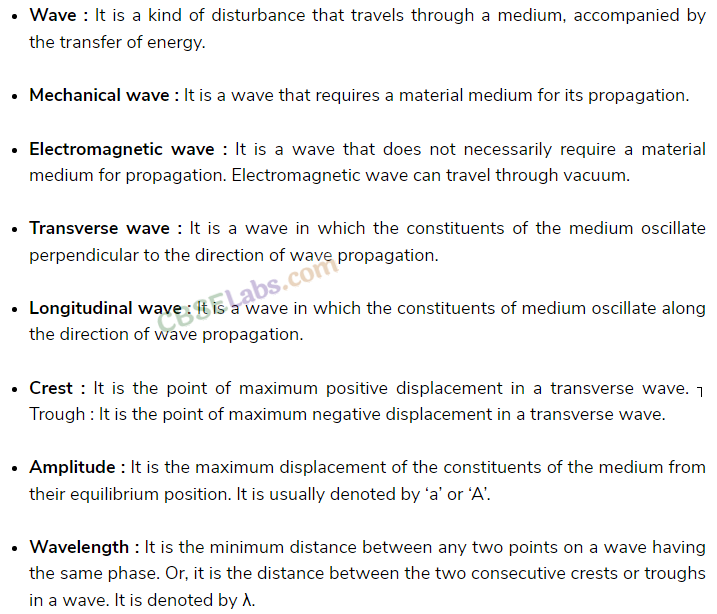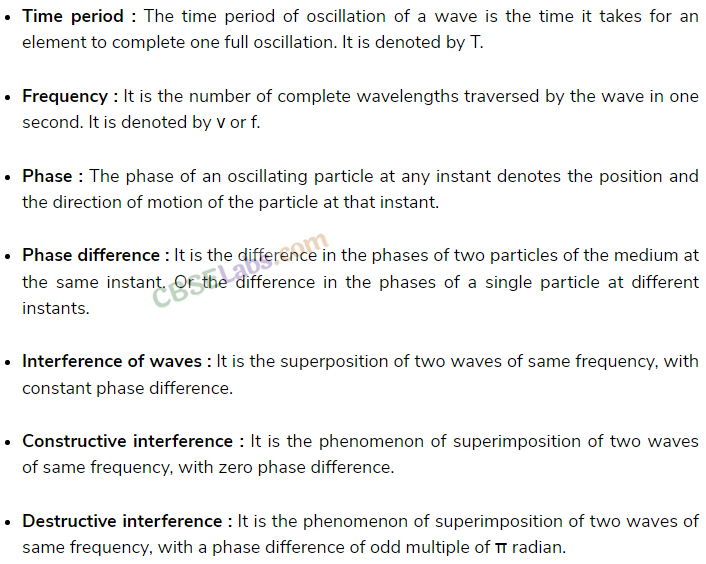Waves Class 11 Notes Physics Chapter 15
• Waves
Wave is a form of disturbance which travels through a material medium due to the repeated f periodic motion of the particles of the medium about their mean positions without any actual
transportation of matter.
• Characteristics of wave
The characteristics of waves are as follows:
(i) The particles of the medium traversed by a wave execute relatively small vibrations about their mean positions but the particles are not permanently displaced in the direction of propagation of the wave.
(ii) Each successive particle of the medium executes a motion quite similar to its predecessors along/perpendicular to the line of travel of the wave.
(iii) During wave motion only transfer of energy takes place but not that of a portion of the medium.
Waves are mainly of three types: (a) mechanical or elastic waves, (b) electromagnetic waves and (c) matter waves.
• Mechanical waves
Mechanical waves can be produced or propagated only in a material medium. These waves are governed by Newton’s laws of motion. For example, waves on water surface, waves on strings, sound waves etc.
• Electromagnetic Waves
These are the waves which require no material medium for their production and propagation, i.e., they can pass through vacuum and any other material medium. Common examples of electromagnetic
waves are visible light; ultra-violet light; radiowaves, microwaves etc.
• Matter waves
These waves are associated with moving particles of matter, like electrons, protons, neutrons etc. Mechanical waves are of two types:
(i) Transverse wave motion, (ii) Longitudinal wave motion,
• Transverse wave motion
In transverse waves the particles of the medium vibrate at right angles to the direction in which the wave propagates. Waves on strings, surface water waves and electromagnetic waves are transverse waves. In electromagnetic waves (which include light waves) the disturbance that travels is not a result of vibrations of particles but it is the oscillation of electric and magnetic fields which takes place at right angles to the direction in which the wave travels.
• Longitudinal wave motion
In these types of waves, particles of the medium vibrate to and fro about their mean position along the direction of propagation of energy. These are also called pressure waves. Sound waves are longitudinal mechanical waves.
• Wavelength
The distance travelled by the disturbance during the time of one vibration by a medium particle is called the wavelength (λ). In case of a transverse wave the wavelength may also be defined as the distance between two successive crests or troughs. In case of a longitudinal wave, the wavelength (λ) is equal to distance from centre of one compression (or refraction) to another.
• Wave Velocity
Wave velocity is the time rate of propagation of wave motion in the given medium. It is different from particle velocity. Wave velocity depends upon the nature of medium.
Wave velocity (υ) = frequency (v) x wavelength (λ)
• Amplitude
The amplitude of a wave is the maximum displacement of the particles of the medium from their mean position.
• Frequency
The number of vibrations made by a particle in one second is called Frequency. It is represented by v. Its unit is hertz (Hz) v =1/T
• Time Period
The time taken by a particle to complete one vibration is called time period.
T = 1/v, it is expressed in seconds.
• The velocity of transverse waves in a stretched string is given by
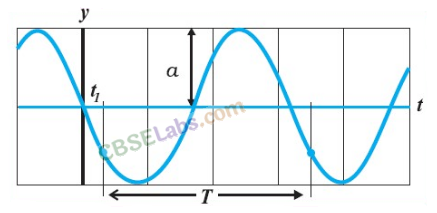
where T is the tension in the string and μ is the mass per unit length of the string, μ is also called linear mass density of the string. SI unit of μ is kg m-1.
• The velocity of the longitudinal wave in an elastic medium is given by
![]()
where E is the modulus of elasticity of the medium and ρ is the density of the medium. In case of solids, E is Young’s modulus of elasticity (Y), then

• Newton’s Formula for the velocity of sound in Air
According to Newton, when sound waves travel in air or in a gaseous media, the change is taking place isothermally and hence, it is found that
![]()
Speed of sound in air at STP conditions, calculated on the basis of Newton’s formula is 280 ms
-1
. However, the experimentally determined values is 332 ms
-1
.
According to Laplace, during propagation of sound waves, the change takes place under adiabatic conditions because gases are thermal insulators and compressions and refractions are alternately taking place with a high frequency.
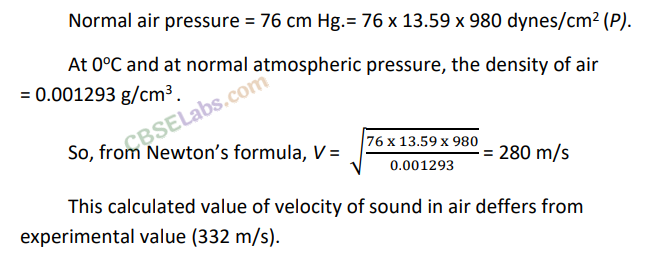
• Factors Influencing Velocity of Sound
The velocity of sound in any gaseous medium is affected by a large number of factors like density, pressure, temperature, humidity, wind velocity etc.
(i) The velocity of sound in a gas is inversely proportional to the square root of density of the gas.
(ii) The velocity of sound is independent of the change in pressure of the gas, provided temperature remains constant.
(iii) The velocity of sound in a gas is directly proportional to the square root of its absolute temperature.
(iv) The velocity of sound in moist air is greater than the velocity of sound in dry air.
(v) If wind flows at an angle θ to the direction of propagation of sound, the velocity of sound is v + w cos θ, where w is the velocity of wind.
• General Equation of Progressive Waves
“A progressive wave is one which travels in a given direction with constant amplitude, i.e., without attenuation.”
As in wave motion, the displacement is a function of space as well as time, hence displacement relation is expressed as a combined function of position and time as:
y (x,t) = A sin (kx — ωt + Ф)
We may also choose a cosine function instead of sine function. Here A, K, ω and Ф are four constant for a given wave and are known as amplitude, angular wave number, angular frequency and initial phase angle of given wave.
• Relation between phase and path difference
![]()
• A wave motion can be reflected from a rigid as well as from a free boundary. A travelling wave, at a rigid boundary or a closed end, is reflected with a phase reversal but the reflection at an open boundary takes place without any phase change.
• The Principle of Superposition of Wave
When any number of waves meet simultaneously at a point in a medium, the net displacement at a given time is the algebraic sum of the displacements due to each wave at that time.
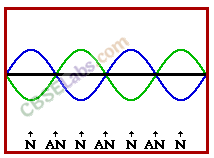
• Standing waves or Stationary waves
When two sets of progressive wave trains of the same type (i.e., both longitudinal or both transverse) having the same amplitude and time period/frequency/ wavelength travelling with same speed along the same straight line in opposite directions superimpose, a new set of waves are formed. These are called stationary waves or standing waves.
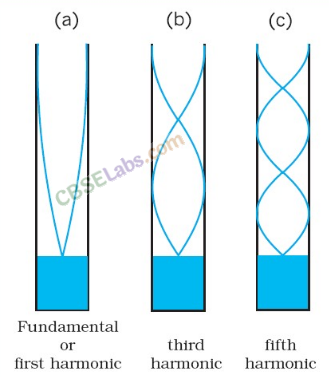
•
Progressive Waves
1. The disturbance progresses on wards; it being handed over from particle to particle. Each particle executes the same type of vibration as the preceding one, though at a different time.
2. The waves are in the form of crests and troughs, i.e., sine/cosine functions, which move on wards with a definite velocity.
3. Every particle has the same amplitude; which it attains in its own time depending upon the progress of the wave.
4. The phase of every particle varies continuously from 0 to 2π .
5. No particle remains permanently at rest. Twice during each vibration, the particles are momentarily at rest. Different particles attain this position at different times.
6. All the particles have the same maximum velocity which they attain one after another, as the wave advances.
7. There is a regular flow of energy across every plane along the direction of propagation of the wave. The average energy in a wave is half potential and half kinetic.
•
Stationary Waves
1. The disturbance is stationary, there being no forward or backward movement of the wave. Each particle has its own vibration characteristics.
2. The waves have the appearance of a sine/cosine function, which shrink to a straight line, twice in each vibration. It never advances.
3. Every particle has a fixed allotted amplitude. Some have zero amplitude (nodes) aiJ some have maximum amplitude (antinodes) always. Each partic1eattains this at the same given moment.
4. All the particles in one-half of the waves have a fixed phase and all the particles in the other half of the wave have the same phase in the opposite direction simultaneously.
5. There are particles -which are permanently at rest (nodes) and all other particles have their own allotted maximum displacement, which they attain simultaneously. These particles are momentarily at rest twice in each vibration, all at the same time.
6. All the particles attain their individual allotted velocities depending upon their positions, simultaneously. Two particles (nodes) in one wave form have zero velocities all the time.
7. There is no flow of energy at all, across any plane. Each particle has its own allotted individual energy. They all attain their values of RE. at one time and all energy becomes KB. at another given time.
• When a stationary wave is set up in a string of length l fixed at its two ends, in the simplest mode of vibration, nodes are formed at the fixed ends and an antinode is formed at the middle point. The frequency of fundamental mode of vibration (or first harmonic) is given by
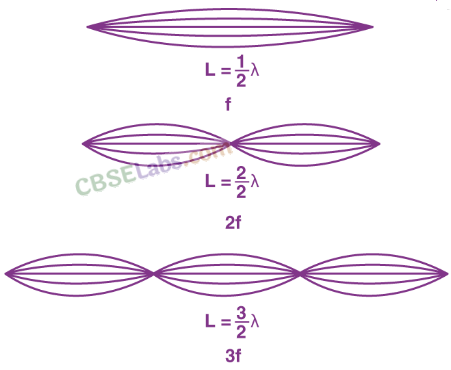
• Frequency of the Stretched String
In general, if the string vibrates in P loops, the frequency of the string under that mode is given by
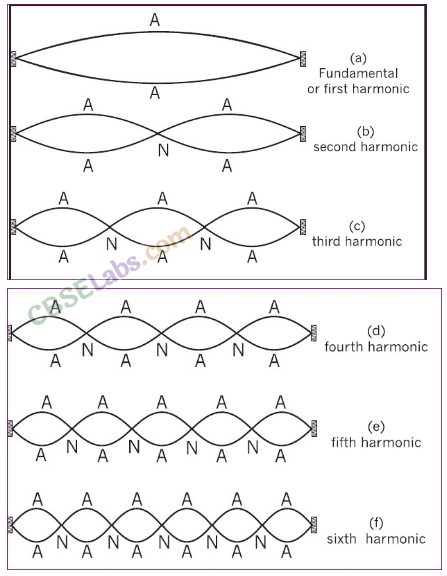
Based on this relation three laws of transverse vibrations of stretched strings arise. They are law of length, law of tension and law of mass.
• Law of Length
The fundamental frequency v is inversely proportional to,the length L of the stretched string.

• Law of Tension
The fundamental frequency is directly proportional to the square root of the tension in the string.

• Law of Mass
The fundamental frequency is inversely proportional to the square root of mass per unit length of the given string when L and T are kept constants.
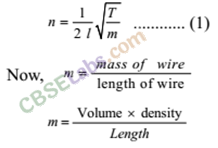
• Beats
The phenomenon of regular rise and fall in the intensity of sound, when two waves of nearly equal frequencies travelling along the same line and in the same direction superimpose each other is called beats.
One rise and one fall in the intensity of sound constitutes one beat and the number of beats per second is called beat frequency. It is given as:
v
b
= (v
1
-v
2
)
where v
1
and v
2
are the frequencies of the two interfering waves; v
1
being greater than v
2
.
• Doppler Effect
According to Doppler’s effect, whenever there is a relative motion between a source of sound and listener, the apparent frequencies of sound heard by the listener is different from the actual frequency of sound emitted by the source.
For sound the observed frequency v’ is given by
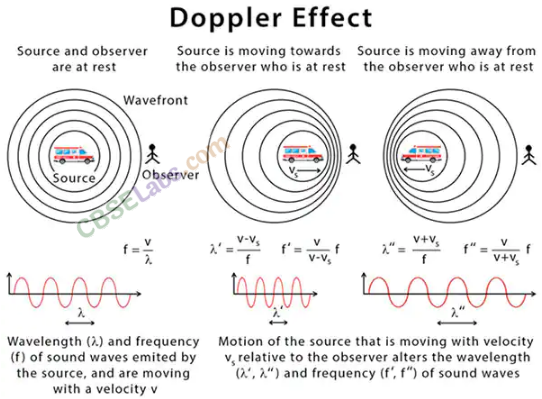
Here v = true frequency of wave emitted by the source, v = speed of sound through the medium, v
0
the velocity of observer relative to the medium and vs the velocity of source relative to the medium. In using this formula, velocities in the direction OS (i.e., from observer towards the source) are treated as positive and those opposite to it are taken as negative.
• IMPORTANT TABLES
